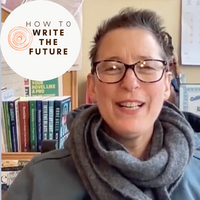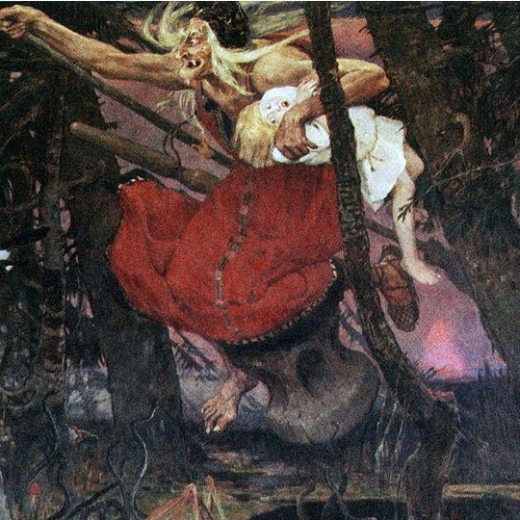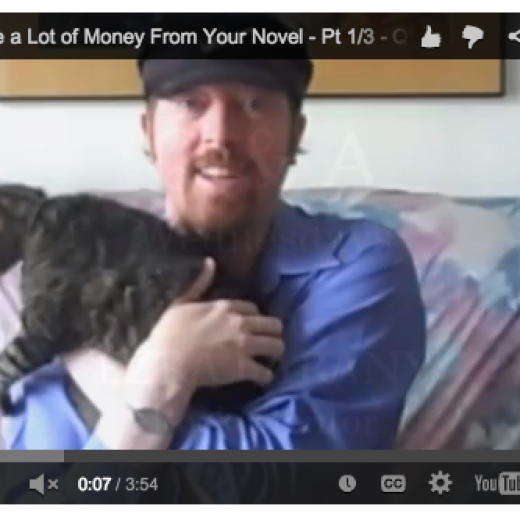World Building and Mental Models
Beth Barany shares insight into building your characters’ reality to make it stand out to readers and how our models of reality can shift in this episode World Building and Mental Models.
Platforms the podcast is available on include Apple Podcasts | Google Podcasts | Spotify | Buzzsprout | Amazon Music | Podcast Addict | Youtube
ABOUT BETH BARANY
 Beth Barany is an award-winning novelist, certified creativity coach for writers, and a workshop facilitator. In addition to her how-to books for writers, Beth has published books in several genres including young adult fantasy, paranormal romance, and science fiction mystery.
Beth Barany is an award-winning novelist, certified creativity coach for writers, and a workshop facilitator. In addition to her how-to books for writers, Beth has published books in several genres including young adult fantasy, paranormal romance, and science fiction mystery.
Learn more about Beth Barany at these sites:
Author site / Coaching site / School of Fiction / Writer’s Fun Zone blog
RESOURCES
The Milky Way Galaxy
https://solarsystem.nasa.gov/resources/285/the-milky-way-galaxy/
Milky Way a part of newly identified galactic super cluster
https://www.firstpost.com/living/milky-way-part-newly-identified-galactic-super-cluster-1697237.html
Flavoring
https://en.wikipedia.org/wiki/Flavoring#Perception_of_flavorings
What gives food flavor?
https://kitchenhelpdot.com/what-gives-food-flavor/
World Building Support on Writers Fun Zone
https://writersfunzone.com/blog/world-building-resources-for-fiction-writers/
Sign up for the 30-minute Story Success Clinic here
https://writersfunzone.com/blog/story-success-clinic/
SHOW NOTES
“We each have unique maps of reality that are specific to our species, specific to our environment, and even down to the specific location where you live, your parents, your heritage, even the food we eat.”
In this podcast episode of How To Write the Future, titled World Building and Mental Models, creativity coach and science fiction and fantasy novelist Beth Barany, shares insight into building your characters’ reality to make it stand out to readers and discusses examples of the ways our models of reality can shift.
ABOUT THE HOW TO WRITE THE FUTURE PODCAST
The How To Write The Future podcast is for science fiction and fantasy writers who want to write positive futures and successfully bring those stories out into the marketplace. Hosted by Beth Barany, science fiction novelist and creativity coach for writers.
Tips for fiction writers!
This podcast is for you if you have questions like:
- How do I create a believable world for my science fiction story?
- How do figure what’s not working if my story feels flat?
- How do I make my story more interesting and alive?
This podcast is for readers too if you’re at all curious about the future of humanity.
TRANSCRIPT for Episode 22 World Building and Mental Models
00:00 You’re Invited to Sign Up for a Story Success Clinic
Hey, science fiction and fantasy authors, would you like to get more exposure for your books and get some support to uncover story ideas, enhance story cohesion, and get some ideas for marketing?
Then sign up for my 30-minute Story Success Clinic.
Every 30-minute story success clinic is recorded and gets aired as an episode of the How To Write The Future podcast.
So sign up today. The link is in the show notes. And now let’s get on with the show.
00:35 PODCAST INTRO
Hey, everyone. Beth Barany here. Welcome creatives. This is a podcast for science fiction and fantasy writers who want to create positive, optimistic stories.
Because when we vision, what is possible, we help make it so.
This podcast is also for readers who are inspired by thinking about the future and about what could be.
01:00 On with the show… We’re Swimming in Our Culture
Alright, so we’re, we’re actually swimming in our culture all the time and that makes it really hard to see what makes things work or even how things could be different.
In NLP we call that ecology. It is everything around us that actually supports us and keeps us operating, functioning, and we also take it for granted.
So like a fish, A fish doesn’t know that it’s swimming in a sea necessarily, and doesn’t even understand or can comprehend the reality of people living on the land walking around on two legs. Humans, we don’t know what it’s like to have the life of a bird, for example, flying and catching food while we, you know, fly midair.
Cats don’t know what it’s like to be a dog, we think so.
So all, all of this to say that we each have unique maps of reality that are specific to our species, specific to our environment, and even down to the specific location where you live, your parents, your heritage, even the food we eat, the air we breathe, and even more broadly, Earth’s gravitational field. It has a very specific impact on us that shapes us in every waking moment.
Our unique place in the solar system, just the earth, the third rock from the sun. And then our solar system is part of the Milky Way galaxy. And that Milky Way galaxy is part of a wider super massive supercluster of galaxies called Laniakea — Laniakea.
So all of these things have an impact on who we are. When you imagine that far out, you know that galaxies of galaxies make this big supercluster called Laniakea. You know, it puts a whole different perspective for me about life on Earth. I find thinking about the stars really comforting. It helps me relax and it actually helps me come back to myself, which brings me back to maps.
03:05 Building Your Fictional World
When we build a fictional world, you wanna situate your character in a specific time and place, which is relative, meaning it’s in relationship to other times and other places, specifically what came before, who came before, and what are the other areas in your region that have an impact or influence or pressure on where your characters live.
So how do we start making these mental models of reality explicit?
All of your characters have mental models of their reality, and you as an author, as a person on this planet right now listening to this have a mental model of reality.
So, let me see if I can define a little bit what I mean by mental model or mental map.
We all unconsciously, mostly unconsciously, develop ways of perceiving the world that we perceive as real or true from the time we are very, very young.
Brain scientists have shown that our brain is predicting what happens in every next second. Before it happens our brain is actually gonna predict what’s gonna happen based on what has come before.
The brain is always constructing models of reality to save time, cuz our brain is all about saving energy and it is building on everything that came before.
04:30 What You Believe is a Good Breakfast
So let’s take an example, Consider something you believe to be true right now that was different than before, and I’m gonna pick something really mundane, like what you believe is a good breakfast.
Chances are years ago, maybe even months ago, you believed something was really excellent for breakfast, that maybe now you don’t.
For example, I used to love eggs for breakfast with kale. I loved it. I would steam the kale with my eggs. It was delicious. And I had that for a few years. And before that though, my very favorite breakfast was peanut butter and banana sandwich on rye toast.
I loved it.
And now I know that those two things … For one hand, you know, eating peanut butter and banana and bread, those are all actually not good for me anymore, and I’m just not interested in eggs and kale for some reason. I don’t know why. Now it’s oatmeal and I add some herbs and spices and a little monk fruit and stevia.
That’s the best breakfast. Absolutely. Hands down, you cannot convince me otherwise.
So this is an example of how our beliefs shift, but also how our model of reality can shift.
And also what we believe is true, that becomes our reality.
Another way of looking at it is beliefs are a scaffolding of our reality, but also the construction material.
Our deeply held beliefs shape our reality because they shape our choices.
Here’s another example. When I was a small child, it was perfectly acceptable for my mom to pile in all of us four kids and friends into the big Ford Station wagon and go grocery shopping with no seat belts. It was in the seventies and early eighties, in Northern California.
But would this happen today?
No way, but it was normal then. No one questioned it. That was our map of reality.
So let’s take it back to your story.
What are the activities and behaviors that your characters take for granted?
Your job as the writer and world builder is to get really, really clear on what is normal for your characters and what is abnormal.
I like to think of a typical day for my characters and ask them questions. Or sometimes I run a mental movie of the day, jotting down anything that stands out different than what I am familiar with than what I would normally experience.
Something to keep in mind is that your readers have this world, the world we live in, to compare with anything that you create.
So you as the writer, need to describe what is strange to us, but normal to your character, in terms that we all can relate to.
For another example, let’s go back to the breakfast example. My main character, Janey McCallister, she has a favorite breakfast too, I’m sure, even though I haven’t highlighted it in my current book that I’m working on, but I do know her habits from her previous, my previous books that I’ve written already, the first four books in the series.
Janey likes coffee like me. Of course, she does, right? I’ve modeled her after me, but I haven’t decided how she makes her coffee because it hasn’t come up in the story.
But I have another character who comes to her house in the story and makes dinner for Janey, but makes it by hand instead of using that stupid food crafter in the kitchen. It’s a 3D printer, a food printer, that everyone can have in their house. It’s as common as, as a microwave or a hot plate. And the food is created out of basic powders that have all the vitamins and micronutrients everyone needs to survive. And there’s flavorings that can be added in a very specific way to give each item its unique flavor and smell.
To think through the 3D printer, food printer, I had to, and I have been researching the amazing rabbit hole that is: what is taste, what is flavor? What determines the taste of food? I really need to understand these things so I can change it in some way for my science fiction story.
And that’s the kind of research I just adore.
And that’s the kind of research and the level of specificity that you need to know to bring your character’s story alive in the minds and your hearts and your readers.
So just a little window into creative process. I usually put what I think is interesting and fun and science fiction-y, cause I’m writing science fiction, obviously put all these interesting things into the story in the earlier drafts, and then in the later drafts, I really work hard to create a wow factor, really emphasize all the ways in which the story world is new and different from ours, but still recognizable.
So I work really hard to bridge the gap so that you could imagine walking into a kitchen and seeing a 3D printer and ordering up your breakfast and whatever.
You want your readers to feel they are somewhere new and that place stretches their notion of what is possible.
And that all comes back to your character’s mental model of reality.
09:42 OUTRO: INVITE TO STORY SUCCESS CLINIC
Write long and prosper.
If you would like help bringing your unique story world to life, then sign up for a Story Success Clinic. I am now scheduling for January 2023.
***
Loved this episode? Leave us a review and rating here: https://www.buzzsprout.com/2012061
or in your podcast home of choice.
***
CONNECT
Contact Beth: https://writersfunzone.com/blog/podcast/#contact
Email: beth@bethbarany.com
LinkedIn: https://www.linkedin.com/in/bethbarany/
CREDITS
EDITED WITH DESCRIPT: https://www.descript.com?lmref=_w1WCA
MUSIC: Uppbeat.io
DISTRIBUTED BY BUZZSPROUT: https://www.buzzsprout.com/?referrer_id=1994465
- SHOW PRODUCTION BY Beth Barany
- SHOW NOTES by Kerry-Ann McDade
***
For more “How To Write the Future” episodes, go here.
If you’d like to invite Beth onto your podcast, drop her a note here.




